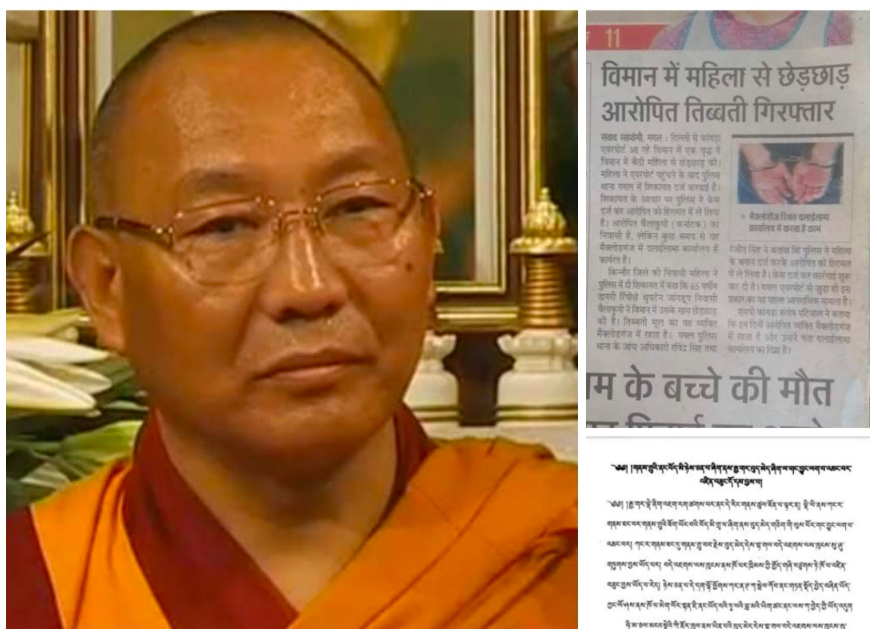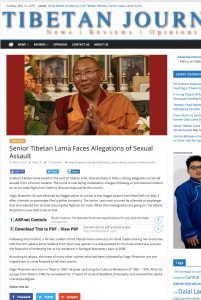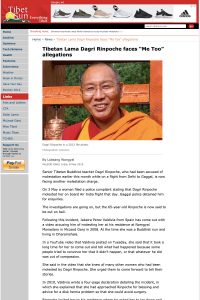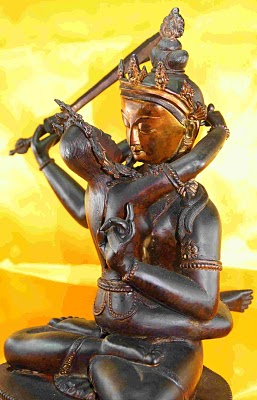
Dagri Rinpoche Thupten Lundrup Tenpey Gyaltsen a.k.a. Thupten Jangchup, who works in the Dalai Lama’s Office and is closely associated with Foundation for the Preservation of the Mahayana Tradition (FPMT) and Sera Jey Monastery, is now in police custody after being accused of assaulting a woman on a Delhi-Dharamsala flight. According to sources, this is not the first time he has done this but the previous incidents were hushed up.
By: Kay Beswick
Indian media has exploded with the recent news of a Tibetan monk-official, Dagri Rinpoche, who is in police custody after being accused of molesting a woman. According to the reports, 65-year-old Dagri Rinpoche, also known as Thupten Lundrup Tenpey Gyaltsen a.k.a. Thupten Jangchup, is a resident of Bylakuppe and works in the Dalai Lama’s Office in Dharamsala. His accuser lodged a complaint at Gaggal police station, alleging that the assault took place on a flight between Delhi and Gaggal Airportin Kangra. Gaggal Airport is the closest airport to serve Dharamsala, where the Central Tibetan Administration (CTA; Tibetan leadership) is based. Everyone also knows that the Indian police are chronically understaffed and overworked, so they will not simply arrest someone based on a flimsy allegation. They must have done preliminary investigations and found something to convince them he is worthy of arrest. It is already well-known in the Tibetan circles that he has been grabbing at women for years now. A few points from this incident are extremely troubling:
- The word used by Indian media to refer to this incident is not merely that Dagri Rinpoche groped the woman through her clothes. It strongly implies that he actively tried to violate her and get his hands under her clothing.
- No one is surprised Dagri Rinpoche was detained for his behavior. The fact he was caught harassing a lady from Kinnaur, a region in India where Tibetan Buddhism is strong and people have a blind faith towards Tibetan monks and lamas, only confirms the news.
- Dagri Rinpoche is not the first person close to the Dalai Lama who has been accused of sexual harassment. Most recently, the Karmapa Ogyen Trinley who is endorsed by the Dalai Lama, has been accused of pursuing women in Taiwan. Similarly, Sogyal Rinpoche, Sakyong Mipham and Tenzin Dhonden (amongst many, many others) were accused of sexual abuse. All of them were heavily endorsed and promoted by the Dalai Lama.
- When questioned, Dagri Rinpoche gave his address as the Dalai Lama’s Office. It was a blatant attempt to absolve himself, and to intimidate the Indian police that they should not pursue the matter any further because he is associated with the Dalai Lama.
This, quite frankly, is disgusting because rather than thinking about the trauma experienced by the victim, Dagri Rinpoche’s first act was to try and protect himself and his reputation, by drawing on his association with the Dalai Lama. The fact Dagri Rinpoche used his closeness with the Dalai Lama to protect himself is precisely the problem. People like Sogyal Rinpoche and Sakyong Mipham were able to abuse women for decades because they felt invincible and entitled to behave however they like, due to their association with the Dalai Lama. Are Dagri Rinpoche’s actions excusable because he is associated with the Dalai Lama? No, because if a crime has been committed and a woman has been harassed, then there must be consequences according to Indian law. In the real world, the trauma experienced by the women victimized by these Dalai Lama-endorsed teachers is very, very real. It does not matter how close these teachers are to the Dalai Lama, because that knowledge does not take away the pain and sense of violation these women feel. Dagri Rinpoche is an incumbent lama of Sera Jey Monasterywhere he was educated for many years and received his Geshe Lharampa degree. Evidently, receiving a Geshe Lharampa degree did not imbue him with a sense of responsibility to protect the public’s view of Buddhism, given that he is dressed in monk’s robes and now accused of molesting a woman in public. A Geshe Lharampa is supposed to be very learned in Buddhism and we assumed he is practicing what he has learned. The crux of the practice is: renunciation, compassion and right view. Obviously his degree has become something of a passport to money and self-benefit, and not so much inner contemplation and transformation.

FPMT often promotes Dagri Rinpoche and he is frequently pictured together with the head of the organization, Lama Zopa. Now that Dagri Rinpoche has been arrested for sexual assault, will FPMT remain silent or will they continue to promote him as a valid source for teachings?
In recent years, Dagri Rinpoche has also been closely associated with Foundation for the Preservation of the Mahayana Tradition (FPMT) who have heavily promoted him as a credible teacher on Buddhism. He is, for example, due to embark on a teaching tour and headline Wesak Day events in South East Asia. He is often invited to FPMT to give teachings in their centres throughout the world. All of these students who have received teachings, commentaries and tantric initiations are now going to be in a very difficult situation, and perhaps lose faith, feel disgust and feel cheated. Do Dagri Rinpoche and FPMT have any consideration for the damage they have done to these students, and consideration for their feelings? ......
The world now waits to see what the Dalai Lama, Sera Jey and FPMT will do. Some people might even say that he was framed but the question is, what would he be framed for? And why him? In FPMT, he may be some superstar but out in the real world, he is a nobody. No doubt attempts will be made to get the police to drop the charges, in sheer disregard for the victim’s experience. In Tibetan society, especially if you are connected to the Dalai Lama, the policy is to protect the abuser and let the victim suffer. Sadly, it is also the case in Tibetan society where you can hold your vows, be kind and be an unblemished representative of the Buddha’s teachings…...However, if you are connected to the Dalai Lama, and you do not practice Dorje Shugden, then you can do whatever you like. But what is more anti-Dalai Lama, practicing Dorje Shugden or giving the Dalai Lama a bad name by abusing women and then trying to protect yourself by showing how close you are to him? In their rush to defend themselves, people like Dagri Rinpoche do not think how their defence may impact the Dalai Lama. They do not see that the public are also starting to question why the Dalai Lama endorses this type of behavior. Is this what the Dalai Lama stands for? Unless the Dalai Lama breaks his silence, then the answer to that question is ‘yes’. It is time for the Dalai Lama to come out to strongly denouncethese people. It is time for him to actively investigate everyone in his office and government, and remove people who have abused their power.

All of these teachers, endorsed by the Dalai Lama, have either been accused of or admitted to sexual abuse. This now includes Dagri Rinpoche who was recently arrested by Indian police. All of these lamas also do not practice Dorje Shugden and hence whatever they do is excusable, as long as they remain financially lucrative for the Tibetan leadership. (Top row L-R: Sogyal Rinpoche, Sakyong Mipham, Gangten Tulku. Bottom row L-R: Lama Norlha, Lama Choedak Rinpoche, Tenzin Dhonden).
Especially for Dagri Rinpoche who works in the Tibetan government’s office and with the Dalai Lama, not only should he be ousted from his position but some sort of repercussion or punishment is also due in accordance with the law. For someone who actually works in the Tibetan government and represents the Dalai Lama, when he commits crimes like this, what kind of example does it set if he is exonerated? Instead of teaching Tibetans to obey the law, people like Dagri Rinpoche show that with power and position, you can behave however you like with no repercussions. Is that the lesson a supposed Geshe Lharampa should be teaching? What teachers like Sogyal Rinpoche, Sakyong Mipham, Tenzin Dhonden and now Dagri Rinpoche have done to these women is highly reprehensible and deserving of the strongest condemnation. It goes against the fundamental tenets of Buddhism which is to do no harm to others and to cause no suffering to them. But Dagri Rinpoche’s victim, who now feels violated, will never look at the monk’s robes in the same way again. Fear, paranoia and trauma are the emotions that she will associate with the robes. This type of damage to Buddhismis palpable, and it is people like Dagri Rinpoche who are responsible, and no one else.
Dalai Lama Office’s Dagri Rinpoche molests women? | Dorje Shugden and Dalai Lama – Spreading Dharma Together



Is Dalai Lama innocent? Does he deserve the title "The Holiness"?
The Tibetan fake Buddhism claims that Mahayoga (the Dual Operations of Bliss and Emptiness) is the most ultimate Buddha dharma. However, it is only the lamas’ wishful thinking. The real Buddha dharma can never be like that. What is the essence of Lamaistic Mahayoga (the Dual Operations of Bliss and Emptiness)? To be frank, it is to have love for all, to “have sexual love with all the beautiful young female followers one by one”. The true meaning of love for all from the Dalai Lama is to make all the beautiful young female followers and lamas dwell in the state of orgasm together. To have the smart wisdom of maintaining orgasm for a long duration and to be willing to make all the females achieve orgasm with happiness for a long time during sexual intercourse are actually the compassion told by the Dalai Lama. In his book, the Dalai Lama says:
A practitioner who has firm compassion and wisdom can make use of sexual intercourse in the spiritual path as a technique for strongly focusing consciousness and manifesting the fundamental innate mind of clear light. Its purpose is to actualize and prolong the deeper levels of mind in order to put their power to use in strengthening the realization of emptiness. (Dalai Lama XIV/translated and edited by Jeffrey Hopkins, Mind of Clear Light: Advice on living well and dying consciously, Atria Books, 2003, p.176.)
He says again in his another book:
According to the New translation Schools, at a certain high point in the practice of Secret Mantra, the mantrika engages in special practices such as making use of a sexual partner, hunting animals, and so forth. Though it is easy to explain the purpose of employing a partner as a means of bringing desire to the path and inducing subtler consciousnesses which realize emptiness, the hunting of animals cannot be explained that way. (The XIV Dalai Lama, Kindness, Clarity, & Insight, Snow Lion Publications, 1988, p.219.)
Obviously, the lamas are using the female followers as the sexual partners to have the practice of extensive copulations. They give it a dignified name and say that it is to “strengthen the realization of emptiness” . Actually, the gurus or lamas desire to have sex with most of the female followers; under the guise of Buddhist term “enlightenment,” they seduce the beautiful young females. (In fact, they refuse to have sex with the ugly old females, violating the spirit of love for all.) What the Dalai Lama preaches is “a fake Buddhism that makes use of sexual partners”.

(The sex scandals about the tantric lamas happen in many different places. The dharma-kings, lamas, or living-buddhas, have copulation with all the beautiful young female believers like this. They dignify it with the name of couple practicing the Dual Operations of Bliss and Emptines
True Face of the Dalai Lama: Playing around with all women in the world (3) The true facts of the Couple-Practice Tantra in Tibetan Buddhism - - 藏传佛教真相|西藏密宗达赖喇嘛六字大明咒男女双修Lama-佛教佛法 (tantrism.net)




















